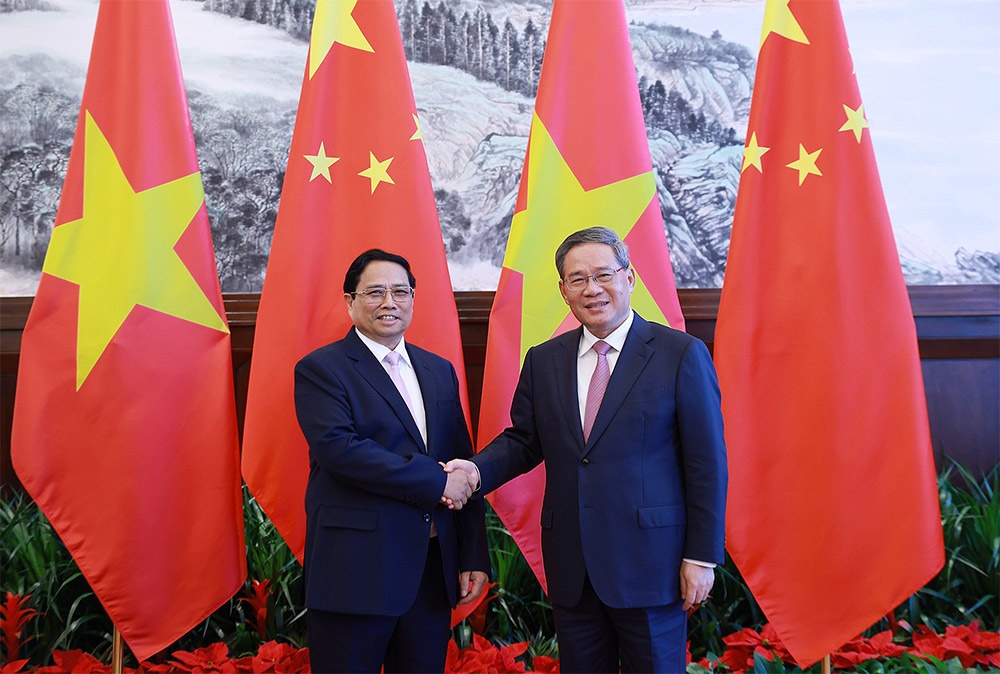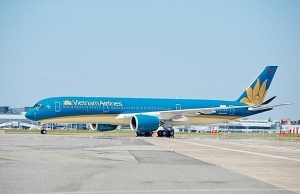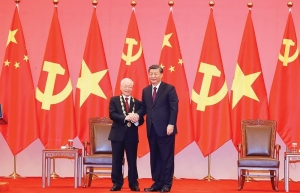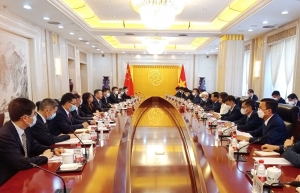Future deals to bode well for China ties
During Prime Minister Pham Minh Chinh’s bilateral talks with Chinese Premier Li Qiang on the sidelines of the 15th World Economic Forum Annual Meeting of the New Champions in Liaoning province, both leaders agreed that Vietnam and China shared a flourishing relationship in trade and investment.
 |
| Vietnam’s Prime Minister Pham Minh Chinh (left) met with Chinese Premier Li Qiang, Photo: Nhat Bac |
PM Chinh urged the two sides to effectively accelerate transport connectivity, especially the construction of railways between Lao Cai, Hanoi, and Haiphong; Lang Son and Hanoi; and more. Both countries should also ink a protocol and complete market opening procedures for Vietnamese frozen durian and fresh coconut, as well as other types of agricultural products, PM Chinh said.
He also asked the Chinese side to create better conditions for the early establishment of the Vietnam Trade Promotion Office in Chengdu, Haikou, and Nanjing. Besides that, both countries will also work on new measures to increase customs clearance efficiency, improve border gates’ infrastructure towards developing smart border gates, while also working on removing bottlenecks of some cooperation projects.
Premier Qiang said that China would further open its market for Vietnamese goods, especially agricultural and aquatic products and high-quality fruits, while also boosting coordination in customs clearance and removing hurdles about policy so that both nations’ trade and investment cooperation can further develop.
China and Vietnam will also increase strategic connectivity and cooperation, especially in infrastructure, transport, economic-trade and investment, particularly in manufacturing and processing, agriculture, supply chains, and financial and monetary cooperation.
Under a joint statement released during a state visit to Vietnam last December by Xi Jinping in his dual capacity as General Secretary of the Communist Party of the China Central Committee and State President, the two nations “agree to apply practical measures to expand the scale of bilateral trade in a balanced and sustainable direction, while promoting the role of the Regional Comprehensive Economic Partnership and the ASEAN-China Free Trade Area; and expanding the export of strong products from one country to another”.
According to the Vietnamese Ministry of Industry and Trade (MoIT), in 2023, total two-way trade turnover between Vietnam and China reached $173.3 billion, down from $175.6 billion in 2022 - with Vietnam’s exports valued at $61.7 billion, up 6.4 per cent on-year, and Vietnam’s imports were worth $111.6 billion, down 6.9 per cent on-year.
Under the MoIT’s calculations, China was responsible for 25.3 per cent of Vietnam’s total trade in 2023, with 17.3 per cent of export turnover and 34 per cent of import value.
In the first five months of this year, the bilateral trade hit $77.5 billion, including Vietnam’s exports of $22.6 billion – up 10.2 per cent on-year, and China’s exports of $54.9 billion – up 33.1 per cent on-year.
The key exports of China to Vietnam include integrated circuits, telephones, sound recordings, electric batteries, and other knitted or crocheted fabrics.
Meanwhile, Vietnam’s main exports to China consist of agricultural products, sound recordings, integrated circuits, broadcasting accessories, office machine parts, and non-retail pure cotton yarn.
According to the Vietnamese Ministry of Planning and Investment, cumulatively as of May 20, Vietnam had about 4,570 Chinese valid ventures registered at $28.1 billion – making China the sixth-largest foreign investor.
In the January-May 20 period, China ranked fourth in Vietnam’s list of foreign investors with total newly registered and newly added capital and capital contributions and stake acquisitions of $1.13 billion – accounting for 10.27 per cent of total.
At last week meeting with Sun Rongkun, chairman of Dalian Locomotive and Rolling Stock Co. Ltd. (CRRC), PM Chinh called on the company to partake in infrastructure development in Vietnam, particularly sizable projects and inter-regional and urban railways.
Rongkun said CRRC, which currently exports its railway products to Vietnam, wants to continue to expand its exports to Vietnam, and boost cooperation in producing rail transport and new energy products here. It also wishes to cooperate in inter-regional, inter-provincial and urban railway projects in Vietnam, particularly urban railway lines in Hanoi and Ho Chi Minh City.
PM Chinh also met with Wang Xiaojun, deputy general manager of Power Construction Corporation of China (PowerChina), recommending the company expand its cooperation and investment in Vietnam in the sectors of renewable energy and infrastructure. PowerChina has been operating in Vietnam since 2000 and is also now interested in developing pumped storage hydropower, wind power in the north, and integrated liquified natural gas.
Last month, PM Chinh met with 19 Chinese business representatives at a meeting in Hanoi that Vietnam prioritises projects involving in innovation, digital transformation, renewable energy, smart cities, manufacturing, and transport infrastructure.
“New projects should centre on developing a sustainable business model that includes Vietnamese businesses in the value and supply chains of regional and global corporations,” the PM said.
 | Vietnam Airlines, Jetstar Pacific halt many routes linking with China Vietnam Airlines and Jetstar Pacific have become the latest Vietnamese carriers to change schedules of flights linking the country with China in the face of the acute respiratory disease caused by the novel coronavirus (nCoV). |
 | Agreements head historic China visit Vietnam and China have further secured bilateral ties with numerous new cooperation deals inked and a strong commitment to facilitate two-way trade and investment. |
 | New transport agreements between Vietnam and China Cooperation between Vietnam and China is expected to be further strengthened, driven by the two countries' recent agreement to facilitate more transport ties by road, air, sea, and river to boost bilateral trade and cultural exchanges. |
What the stars mean:
★ Poor ★ ★ Promising ★★★ Good ★★★★ Very good ★★★★★ Exceptional
Related Contents
Latest News
More News
- Ho Chi Minh City backs $2 billion AI data centre with dedicated task force (January 06, 2026 | 08:43)
- PM sets January deadline for high-speed rail consultant (January 06, 2026 | 08:40)
- New decree spurs on PPP implementation (December 31, 2025 | 19:01)
- Global alliance develops $1 billion AI data centre network in Vietnam (December 30, 2025 | 10:08)
- Standing out in the Chinese outbound investment wave (December 29, 2025 | 10:29)
- Bright spots obvious in foreign investment mission (December 29, 2025 | 09:00)
- Ho Chi Minh City hits $8.37 billion in FDI (December 29, 2025 | 08:28)
- Vietnam and UK cooperation backs finance talent for IFCs (December 27, 2025 | 16:31)
- Global partnerships key to Vietnam’s IFC development (December 26, 2025 | 16:18)
- Vingroup pulls out of bid to invest in North-South high-speed railway (December 26, 2025 | 11:42)

 Tag:
Tag:



















 Mobile Version
Mobile Version